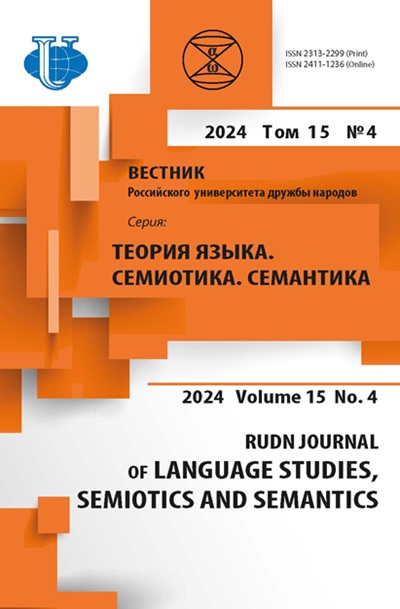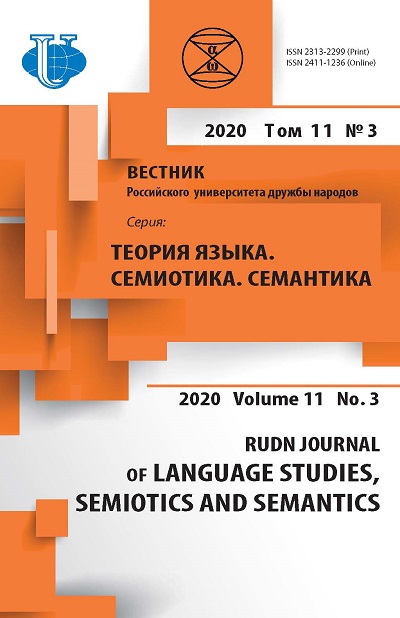Фрактально-семиотическое моделирование концепта ЧАША в религиозных текстах
- Авторы: Ко Ч.И.1
-
Учреждения:
- Государственный университет Чжэнчжи
- Выпуск: Том 11, № 3 (2020)
- Страницы: 448-462
- Раздел: КОГНИТИВНЫЕ ИССЛЕДОВАНИЯ В ЯЗЫКЕ
- URL: https://journals.rudn.ru/semiotics-semantics/article/view/24599
- DOI: https://doi.org/10.22363/2313-2299-2020-11-3-448-462
Цитировать
Полный текст
Аннотация
В статье рассматривается с позиции фрактальной семиотики концепт ЧАША как особый семиотический объект в поле взаимодействия языка и культуры. Актуальность темы исследования обусловлена повышением интереса к применению системного подхода в изучении лингвистического объекта, в частности к использованию фрактального подхода для рассмотрения структуры концепта, включающей образные и рефлективные компоненты. Предмет рассмотрения представляет собой фрактальная организация концепта ЧАША в речемыслительном процессе. Механизм данного концепта, функционируя на мегауровне духовной семиосферы и микроуровне текста, обусловлен особенностями организации речевой деятельности, где проявляется синергетический принцип целостности. Новизна данной работы заключается в том, что предлагается опыт представления структуры концепта ЧАША, реконструируемой на основе русских контекстов с религиозным содержанием. «Фрактальность» этой структуры обусловлена «нелинейным» характером развития ряда символизированных значений (ЛСВ) чаша. Количественные данные об употреблении ЛСВ позволяют проследить особенности символизации в направлении «предмет → символ» и обосновать возможность применения концепции фрактала в качестве лингвистического подхода. Материалом для анализа послужили такие религиозные тексты, отличающиеся паттерном имплицитных смыслов и иерархичностью внутренней организации, как толкования писания, наставление о духовной жизни, святоотеческое наследие и проповеди. Целью настоящей работы являются представление структуры концепта ЧАША и выявление ее специфики динамической природы с учетом инореферентных и самореферентных знаков, а также рассмотрение соответствующих паттернов мышления, которые многократно репрезентируются в религиозных контекстах. Проведенный анализ продемонстрировал, что семантика концепта ЧАША вбирает в себя большой объем символических значений. Установлено, что на лексическом уровне языковая единица чаша со временем формируется и начинает функционировать абстрактное комплексное значение, называемое инвариантным. Данные комплексные инварианты представляют собой скорее открытые концептуальные схемы, которым придается значение в зависимости от контекстуальных условий, и происходит это в результате выполнения когнитивных операций на концептуальном уровне.
Ключевые слова
Об авторах
Чун Ин Ко
Государственный университет Чжэнчжи
Автор, ответственный за переписку.
Email: keqy@nccu.edu.tw
кандидат филологических наук, ассистент-профессор факультета славистики
64, yл. Чжинан, Тайбэй, Китайская Республика, 11605Список литературы
- Кравченко А.В. О традициях, языкознании и когнитивном подходе // Горизонты современной лингвистики: Традиции и новаторство. М.: Языки славянских культур, 2009. С. 51-65.
- Матурана У., Варела Ф. Древо познания. М.: Прогресс-Традиция, 2001.
- Мандельброт Б. Фрактальная геометрия природы. М.: Институт компьютерных исследований, 2002.
- Тарасенко В.В. Фрактальная семиотика: «слепые пятна», перипетии и узнавания. М.: Книжный дом «ЛИБРОКОМ», 2012.
- Степанов Ю.С. Протей: Очерки хаотический эволюции. М.: Языки славянской культуры, 2004.
- Кубрякова Е.С., Ирисханова О.К. Языковое абстрагирование в наименованиях категорий // Известия РАН. Сер. лит. и яз. 2007. Т. 66. № 2. С. 3-12.
- Кубрякова Е.С. Язык и знание: На пути получения знаний о языке: Части речи с когнитивной точки зрения. Роль языка в познании мира. М.: Языки славянской культуры, 2004.
- Пономаренко Е.В. Основная функциональная лингвосинергетика: учеб. пособие. М.: МГИМО-Университет, 2015.
- Флоренский П. Философия культа (Опыт православной антроподицеи). М.: Мысль, 2004.
- Колесов В.В. Введение в концептологию: учеб. пособие. М.: ФЛИНТА: Наука, 2016.
- Лотман Ю.М. Внутри мыслящих миров. Человек - текст - семиосфера - история. М.: Языки русской культуры, 1999.
- Даль В.И. Толковый словарь живого великорусского языка Т. 4. М.: РИПОЛ классик, 2006.
- Срезневский И.И. Материалы для словаря древне-русского языка по письменным памятникам Т. 3. СПб.: Типография императорской академии наук, 1912.
- Черных П.Я. Историко-этимологический словарь современного русского языка. М.: Русский язык, 2006.
- Ефремова Т.Ф. Новый словарь русского языка. Толково-словообразовательный. М.: Русский язык, 2000.
- Кузнецов С.А. Большой толковый словарь русского языка. СПб.: НОРИНТ, 2000.
- Фасмер М. Этимологический словарь русского языка: В 4 т. Т. 4. М.: Астрель, 2004.
- Дьяченко Г. Полный церковно-славянский словарь. М.: Издательский отдел Московского Патриархата, 1993.
- Бабенко Л.Г. Большой толковый словарь русских глаголов. М.: АСТ-ПРЕСС КНИГА, 2007.
- Бабенко Л.Г. Большой толковый словарь русских существительных. М.: АСТ-ПРЕСС КНИГА, 2005.
- Бабенко Л.Г. Словарь-тезаурус русских прилагательных, распределенных по тематическим группам. М.: Проспект, 2011.
- Werth P. Text words: Representing Conceptual Space in discourse. Serie: textual explorations. London: Longman, 1999.
- Князева Е.Н., Курдюмов С.П. Законы эволюции и саморазвития сложных систем. М.: Наука, 1994.
- Жаботинская С.А. Принципы создания ономасиологических моделей и событийных схем в языке // Горизонты современной лингвистики: Традиции и новаторство. М.: Языки славянских культур, 2009. С. 381-400.
- Добротолюбие в 5 томах. М.: Сибирская Благозвонница, 2010.
- Полное собрание творений святителя Игнатия Брянчанинова в 8 тт. М.: Поломникъ, 2001-2007.
- Симфония по творениям святителя Иоанна Златоуста в 2 тт. М.: ДАРЪ, 2008.
- Симфония по творениям святого праведного Иоанна Кронштадтского. М.: ДАРЪ, 2007.
- Сокровище духовной мудрости в 12 тт. М.: Издание Московский духовной Академии и Введенской Оптинской Пустыни, 2003-2011.
- Симфония по творениям святителя Григория Богослова. М.: ДАРЪ, 2008.
- Одэн Томас К. Библейские комменатрии отцов Церкви и других авторов I - VIII веков. Тверь: Герменевтика, 2001-2011.
- Виноград В.В. Язык Пушкина: Пушкин и истории русского литературного языка. М.; Л.: Academia, 1935.
- Лопухин А.П. Толковая Библия, или Комментарий на все книги Св. Писания Ветхого и Нового Завета. Ветхий Завет: в 5 тт. М.: Даръ, 2008.
- Лагута О.Н. Исцеление души: метафорики сотериологии и науки. Критика и семиотика. 2004. № 7. С. 264-278.
- Арутюнова Н.Д. Язык и мир человека. М.: Языки русской культуры, 1999.
- Симфония по творениям преподобных Оптинских старцев в 2 тт. М.: ДАРЪ, 2009.
- Агаркова Н.Э. Деньги // Антология концептов. М.: Гнозис, 2007. С. 304-323.
- Балакин С.В. Фрактальный характер пропозиции при деривационных процессах // Слово, высказывание, текст в когнитивном, прагматическом и культурологическом аспектах: материалы VIII Междунар. науч. конф. Челябинск: Энциклопедия, 2016. С. 8-11.
- Бронник Л.В. О фрактальном самоподобии в языке // Извести Волг. гос. пед. университета. № 10. Т. 44. 2009. С. 15-19.
- Жаткин Д.Н. “Чаша жизни” в русской поэзии // Русская речь. М. 2006. № 1. С. 9-13.
- Жуков Д.С., Лямин С.К. Методология фрактального моделирования в исторических, политологических и иных социальных исследованиях: особенности понятийного и аналитического аппарата // Вестник ТГУ, вып. 7 (87), 2010. С. 223-234.
- Манаков Н.А., Москальчук Г.Г. Фрактальная природа языка // Лингвосинергетика: проблемы и перспективы. Барнаул: Алтайский гос. ун-т, 2000. С. 24-33.
- Архимандрит Иоанн (Крестьянкин). Ангел Хранитель. М.: Братство святого апостола Иоанна Богослова, 2011.
- Архимандрит Иоанн (Маслов). Прп. Амвросий Оптинский и его эпистолярное наследие. М.: Издание Братства святителя Алексея, 1993.
- Архимандрит Пантелеимон. Отец Иоанн. Новый Валаам: Издание Ново-Валаамского монастыря, 1992.
- Игумен Никон (Воробьев). О начале жизни. М.: Издательство Московской Патриархии Русской Православной Церкви, 2013.
- Игумен Сергий (Рыбко). Жизнь - это экзамен на любовь. М.: Красный Пролетарий, 2005.
- Козаченко В. Для чего мы живем. М.: Ковчег, 2013.
- Митрополит Вениамин (Федченков). О вере, неверии и сомнении. М.: Русло, 1992.
- Протоиерей Константин Островский. Вечность - у дверей. Заметки священника. Красноярск: Успенский храм, 2010.
- Протоиерей Николаев Сергий. Секреты любви. За советом и утешением к батюшке. Проповеди и размышления. М.: Ковчег, 2012.
- Симфония по творениям преподобного Ефрема Сирина. М.: ДАРЪ, 2008.
- Симфония по творениям святителя Василия Великого. М.: ДАРЪ, 2008.
- Симфония по творениям святителя Тихона Задонского. М.: ДАРЪ, 2007.
- Чернышев В.И. Словарь современного русского литературного языка Т. 17. М.-Ленинград: Наука, 1965.
- Шапошников А.К. Этимологический словарь современного русского языка. Сост. А.К. Шапошников: в 2 т. Т. 2. М.: Флинта: Наука, 2010.
- Шведова Н.Ю. Русский семантический словарь Т. 2. Толковый словарь, систематизированный по классам слов и значений. М.: ИРЯ им. В.В. Виноградова РАН, 2002.
- Шведова Н.Ю. Толковый словарь русского языка с включением сведений о происхождении слов. Отв. ред. Н.Ю. Шведова. М.: Азбуковник, 2011.












